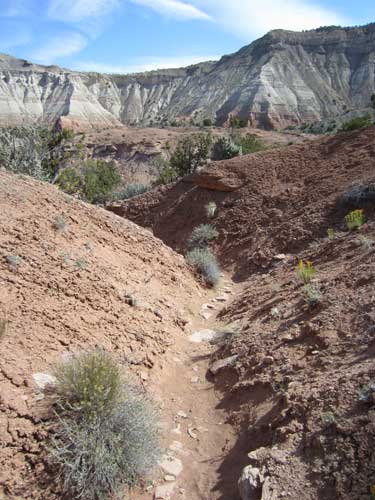KODACHROME BASIN STATE PARK (Day 21 - part 3)
I then began the walk back. For the most part, it was easy enough to follow the sign posts, since the trail itself wasn't always clear.


A peak over the mesa edge

Wandering back through the odd 'mud fields'


Passing back by the first overlook

This is clear...

... but this wasn't. This "path" turned out to just be a river wash that dead-ended at a steep ledge.

This was the actual trail that I had missed (note the distant marker).

This lizard (possibly a female because the markings aren't very distinct) seems to have lost her tail. This defense mechanism is called autotomy and is meant to distract an attacking predator so the actual lizard can escape.
The tail has 'fracture planes' (either between vertebrae or in the middle of each one). When the tail is dropped, everything separates... skin, muscles, blood supply, nerves and bone... leaving exposed muscle over the bone. Eventually this will dry out, forming a cap over the stump, and the skin will start to regrow. While the tail will often regenerate, it is generally not the same length or color as it was before and it may have abnormal scales or patterns. It also has a rod of cartilage instead than bone and it usually cannot be dropped again.
Tail loss causes some issues for the lizard. It can affect its sense of balance and can also result in the loss of critical fat deposits. Healing also takes a significant amount of energy, putting these lizards at a greater risk for nutritional deficiencies. And finally, the lizard has lost one of its greatest means of defense.


Note the marker? Yup, this is the official trail.


A view of the trail leading back down into the canyon


Back down in the canyon

Dead trees not only made nice perches for the bluebirds,...

... they also provided great opportunties for wood photos!

Prince's Plume is a native plant in the mustard family.


A view of the Angel's Palace Trail mesa
Next I decided to do the Grand Parade Trail, which I had seen below me from Angel's Palace Trail.. It was only a mile and half, stayed on the basin floor and explored two box canyons. Sounded fun and easy!

Map of the trail, including the two box canyons

Some of the best the park has to offer in one shot... the imposing Grey Cliffs and a shapely sedimentary pipe

Distinctive rock layers

Heading out


More cryptobiotic soil...

... that someone has carved a home into!

Possibly this little guy! Note the four paws and long tail.

The robber fly (or assassin fly) is one fierce predator. It knocks its victim right out of the air, then stabs it with its strong proboscis, injecting its victim with a neurotoxic enzyme that rapidly paralyzes and liquifies it, then sucks up the gooey insides.

The cliffs were full of crevices...




Fourwing Saltbush is highly tolerant of drought, temperature changes and soil conditions. Male and female flowers are on separate plants (dioecious). The fruit and seed are enclosed in winged bracts.

Skunkbush (also sourberry and three-leaf sumac) can be found from deserts to mountain peaks up to 7,000 feet.


Continuing down the path

The turnoff for the first box canyon
return • continue

